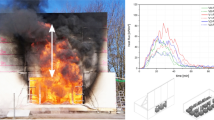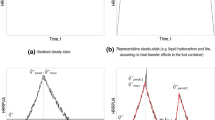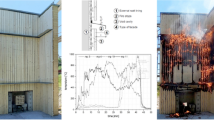Abstract
Extreme fire events in tunnels can have catastrophic consequences, including loss of lives, structural damage, and major socioeconomic impacts. The fire scenario itself is one of the primary parameters that would influence the level of damage in a tunnel. Standard hydrocarbon fire temperature–time curves exist but they are idealized and do not consider the actual fire duration and potential for fire spread within the tunnel. Furthermore, risk-based decision-making frameworks and performance-based design of tunnel linings require realistic sets of fire scenarios to quantify damage. This paper focuses on quantifying uncertainties in the temperature–time evolution of railway tunnel fires considering fire spread between train cars. In this study, 540 numerical simulations are conducted in fire dynamics simulator by varying ventilation velocity, amount of fuel, tunnel slope, ignition point, and criteria for fire spread between railcars. Temporal and spatial distribution of fire temperature in the tunnel is studied. The resulting 540 temperature–time curves at sections with the highest temperature are analyzed and statistics of the maximum fire temperature and duration, heating rate, and decay rate are provided. Fires with heat release rates larger than 40 MW are categorized as high-intensity with mean maximum temperature of 1007°C. Fires with heat release rates smaller than 30 MW are categorized as low-intensity with a mean maximum temperature of 245°C. The proposed framework can be expanded in future to establish guidelines for temperature demands in the design of concrete tunnel linings within risk-based frameworks to achieve required performance levels in railway tunnel fire events.

Adapted from [29]






Adapted from [59]

Adapted from [62]












Similar content being viewed by others
References
Casey N (2019) Fire incident and fire safety operational data for major Australian road tunnels. Technical report AP-T341-19. Austroads Sydney, Australia
Schütz D (2014) Fire protection in tunnels: focus on road & train tunnels. Tech Newsl SCOR Glob P&C
Maraveas C, Vrakas AA (2014) Design of concrete tunnel linings for fire safety. Struct Eng Int 24 (3):319–329
Chow WK, Li JSM (1999) Safety requirement and regulations reviews on ventilation and fire for tunnels in the Hong Kong Special Administrative Region. Tunn Undergr Space Technol 14 (1):13–21. https://doi.org/10.1016/S0886-7798(99)00009-7
Fridolf K, Nilsson D, Frantzich H (2013) Fire evacuation in underground transportation systems: a review of accidents and empirical research. Fire Technol 49 (2):451–475. https://doi.org/10.1007/s10694-011-0217-x
Mashimo H (2002) State of the road tunnel safety technology in Japan. Tunn Undergr Space Technol 17 (2):145–152. https://doi.org/10.1016/S0886-7798(02)00017-2
Modic J (2003) Fire simulation in road tunnels. Tunn Undergr Space Technol 18 (5):525–530. https://doi.org/10.1016/S0886-7798(03)00069-5
Nilsson D, Johansson M, Frantzich H (2009) Evacuation experiment in a road tunnel: a study of human behaviour and technical installations. Fire Saf J 44 (4):458–468. https://doi.org/10.1016/j.firesaf.2008.09.009
Van Coile R, Hopkin D, Lange D, Jomaas G, Bisby L (2019) The need for hierarchies of acceptance criteria for probabilistic risk assessments in fire engineering. Fire Technol 55 (4):1111–1146. https://doi.org/10.1007/s10694-018-0746-7
NFPA (2017) NFPA 502: standard for road, tunnels, bridges, and other limited access highways
Maevski I (2011) Design fires in road tunnels, a synthesis of highway practice. Transportation Research Board NCHRP National Cooperative Highway Research Program Synthesis 415
Bamonte P, Felicetti R, Gambarova PG, Nafarieh A (2011) On the fire scenario in road tunnels: a comparison between zone and field models. Appl Mech Mater 82:764–769. https://doi.org/10.4028/www.scientific.net/AMM.82.764
EFNARC (2006) Specification and guidelines for testing of passive fire protection for concrete tunnels linings. EFNARC
Souza R, Rosignuolo F, Andreini M, La Mendola S, Knaust C (2017) Probabilistic thermo-mechanical analysis of a concrete tunnel lining subject to fire. In: IFireSS 2017—2nd international fire safety symposium, Naples, Italy, pp 997–1004
Van Coile R, Caspeele R, Strauss A, Bergmeister K, Taerwe L (2014) Applied methodology for calculating the structural safety of tunnel linings exposed to fire. In: 10th CCC congress
Carvel RO, Beard AN, Jowitt PW (2001) The influence of longitudinal ventilation systems on fires in tunnels. Tunn Undergr Space Technol 16 (1):3–21. https://doi.org/10.1016/S0886-7798(01)00025-6
Meng Q, Qu X (2011) A probabilistic quantitative risk assessment model for fire in road tunnels with parameter uncertainty. Int J Reliab Saf 5:285–298. https://doi.org/10.1504/ijrs.2011.041181
Cheong MK, Spearpoint M, Fleischmann C (2008) Design fires for vehicles in road tunnels
Li YZ, Ingason H (2010) Maximum ceiling temperature in a tunnel fire. SP report. SP Technical Research Institute of Sweden, Borås
Li YZ, Ingason H (2012) The maximum ceiling gas temperature in a large tunnel fire. Fire Saf J 48:38–48
Li YZ, Lei B, Ingason H (2011) The maximum temperature of buoyancy-driven smoke flow beneath the ceiling in tunnel fires. Fire Saf J 46 (4):204–210
Ingason H, Li YZ, Lönnermark A (2014) Tunnel fire dynamics. Springer, New York. https://doi.org/10.1007/978-1-4939-2199-7
Guo Q, Root K, Carlton A, Quiel SE, Naito CJ (2019) Framework for rapid prediction of fire-induced heat flux on concrete tunnel liners with curved ceilings. Fire Saf J 109 (Oct.):16. https://doi.org/10.1016/j.firesaf.2019.102866
McGrattan K, Hostikka S, McDermott R, Floyd J, Weinschenk C, Overholt K (2013) Fire dynamics simulator user’s guide. NIST Special Publication 1019 (6)
Atkinson GT, Wu Y (1996) Smoke control in sloping tunnels. Fire Saf J 27 (4):335–341
Carvel RO, Beard AN, Jowitt PW, Drysdale DD (2004) The influence of tunnel geometry and ventilation on the heat release rate of a fire. Fire Technol 40 (1):5–26. https://doi.org/10.1023/b:fire.0000003313.97677.c5
Chow W, Wong K, Chung W (2010) Longitudinal ventilation for smoke control in a tilted tunnel by scale modeling. Tunn Undergr Space Technol 25 (2):122–128
Lee SR, Ryou HS (2005) An experimental study of the effect of the aspect ratio on the critical velocity in longitudinal ventilation tunnel fires. J Fire Sci 23 (2):119–138
McGrattan K, Hamins A (2006) Numerical simulation of the Howard Street Tunnel fire. Fire Technol 42 (4):273–281
McGrattan K, Hamins A (2003) Numerical simulation of the Howard Street Tunnel fire, Baltimore, Maryland, July 2001. Spent Fuel Project Office, Office of Nuclear Material Safety and Safeguards, Rockville
Amtrak tunnels. https://en.wikipedia.org/wiki/Category:Amtrak_tunnels. Accessed 20 Jan 2019
CSX Transportation tunnels. https://en.wikipedia.org/wiki/Category:CSX_Transportation_tunnels. Accessed 20 Jan 2019
Carvel RO, Beard AN, Jowitt PW (2005) Fire spread between vehicles in tunnels: effects of tunnel size, longitudinal ventilation and vehicle spacing. Fire Technol 41 (4):271–304
Carvel RO (2004) Fire size in tunnels. Heriot-Watt University, Riccarton
Lönnermark A, Ingason H (2004) Recent achievements regarding heat release and temperatures during fires in tunnels. In: Safety in infrastructure-Svédületes!, Budapest 20th–21st October 2004
Lattimer BY, McKinnon M (2018) A review of fire growth and fully developed fires in railcars. Fire Mater 42 (6):603–619
Lönnermark A, Claesson A, Lindström J, Li YZ, Kumm M, Ingason H (2012) Full-scale fire tests with a commuter train in a tunnel. SP report. SP Technical Research Institute of Sweden, Borås
Stahlanwendung S (1995) Fires in transport tunnels: report on fullscale tests. EUREKA Project EU 499 FIRETUN 549
Li Y, Ingason H (2015) A new methodology of design fires for train carriages based on exponential curve method. Fire Technol. https://doi.org/10.1007/s10694-015-0464-3
Fire and smoke control in road tunnels (1999). PIARC Committee on Road Tunnels, Paris, France
Road tunnels: operational strategies for emergency ventilation (2011). PIARC Committee on Road Tunnels, Paris, France
Design fire characteristics for road tunnels (2011). PIARC Technical Committee 3.3 Road Tunnel Operation
Li YZ, Lei B, Ingason H (2010) Study of critical velocity and backlayering length in longitudinally ventilated tunnel fires. Fire Saf J 45 (6–8):361–370
Roh JS, Ryou HS, Kim DH, Jung WS, Jang YJ (2007) Critical velocity and burning rate in pool fire during longitudinal ventilation. Tunn Undergr Space Technol 22 (3):262–271
Tanaka F, Takezawa K, Hashimoto Y, Moinuddin KA (2018) Critical velocity and backlayering distance in tunnel fires with longitudinal ventilation taking thermal properties of wall materials into consideration. Tunn Undergr Space Technol 75:36–42
Weng M, Lu X, Liu F, Shi X, Yu L (2015) Prediction of backlayering length and critical velocity in metro tunnel fires. Tunn Undergr Space Technol 47:64–72
Wu Y, Bakar MA (2000) Control of smoke flow in tunnel fires using longitudinal ventilation systems—a study of the critical velocity. Fire Saf J 35 (4):363–390
Lee Y, Tsai K (2012) Effect of vehicular blockage on critical ventilation velocity and tunnel fire behavior in longitudinally ventilated tunnels. Fire Saf J 53:35–42
Oka Y, Atkinson GT (1995) Control of smoke flow in tunnel fires. Fire Saf J 25 (4):305–322
Branch RAI (2010) Technical investigation report concerning the fire on Eurotunnel freight shuttle 7412 on 11 September 2008. Rail Accident Investigation Branch, Derby
Carvel R (2010) Fire dynamics during the channel tunnel fires. In: Lonnermark A, Ingason H (eds) Proceedings of the 4th international symposium on tunnel safety & security, Frankfurt am Main, Germany, pp 463–470
Ingason H, Li YZ, Lönnermark A (2015) Runehamar tunnel fire tests. Fire Saf J 71:134–149
Lemaire T (2004) Runehamar tunnel fire tests: radiation, fire spread and back layering. In: International symposium on catastrophic tunnel fires (CTF), SP report, vol 2004:05, Borås, Sweden
Lönnermark A, Ingason H (2006) Fire spread and flame length in large-scale tunnel fires. Fire Technol 42 (4):283–302
Andreini A, Da Soghe R, Facchini B, Giusti A (2011) Fire scenarios modelling for the safe design of a passenger rail carriage. In: 9th world congress of railway research, Lille, France
Superliner (railcar). https://en.wikipedia.org/wiki/Superliner_(railcar). Accessed Dec 2018
Forney GP (2017) Smokeview (version 5)-a tool for visualizing fire dynamics simulation data, volume I: user’s guide
Li YZ, Ingason H, Lönnermark A (2012) Numerical simulation of Runehamar tunnel fire tests. In: 6th international conference tunnel safety and ventilation, Graz, Austria, pp 203–210
MassDOT and FHWA (1995) Memorial tunnel fire ventilation test program: test report. Central Artery/Tunnel Project. Massachusetts Highway Department and Federal Highway Administration
Giblin KA (1997) The Memorial Tunnel fire ventilation test program. ASHRAE J 39 (2):26
Luchian SF (1997) Memorial Tunnel fire test program. TR News, vol 190, May–June
Ministry of Transportation and Public Works of the Netherlands (1999) Evaluation of Memorial Tunnel CFD simulations. Ministry of Transportation and Public Works of the Netherlands, The Hague
Risher J, Rhodes S (1995) Toxicological profile for fuel oils. U.S. Department of Health and Human Services, Public Health Service, Agency for Toxic Substances and Disease Registry, Atlanta
Kim E, Woycheese JP, Dembsey NA (2008) Fire dynamics simulator (version 4.0) simulation for tunnel fire scenarios with forced, transient, longitudinal ventilation flows. Fire Technol 44 (2):137–166
Hurley MJ, Gottuk DT, Hall Jr JR, Harada K, Kuligowski ED, Puchovsky M, Watts Jr JM, Wieczorek CJ (2015) SFPE handbook of fire protection engineering. Springer, Berlin
Funding
This work was supported by CAIT Region 2 UTC Consortium.
Author information
Authors and Affiliations
Corresponding author
Additional information
Publisher's Note
Springer Nature remains neutral with regard to jurisdictional claims in published maps and institutional affiliations.
Rights and permissions
About this article
Cite this article
Hua, N., Tessari, A. & Elhami-Khorasani, N. Quantifying Uncertainties in the Temperature–Time Evolution of Railway Tunnel Fires. Fire Technol 57, 361–392 (2021). https://doi.org/10.1007/s10694-020-01007-8
Received:
Accepted:
Published:
Issue Date:
DOI: https://doi.org/10.1007/s10694-020-01007-8





